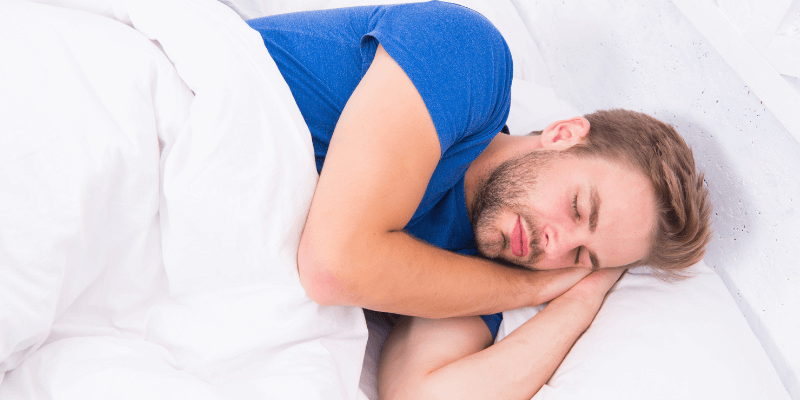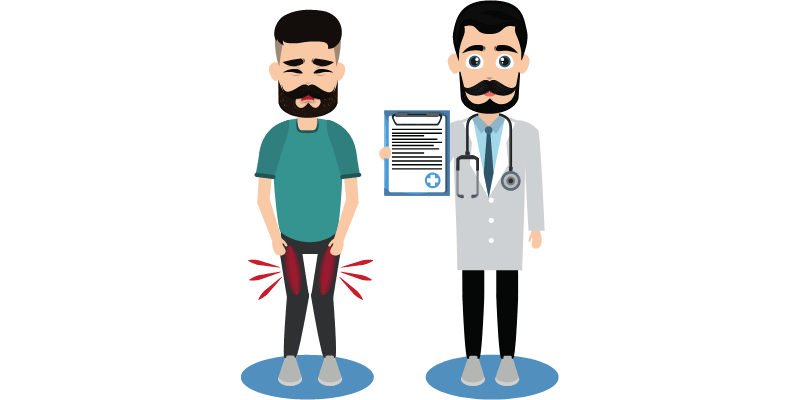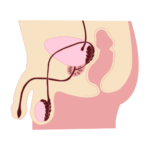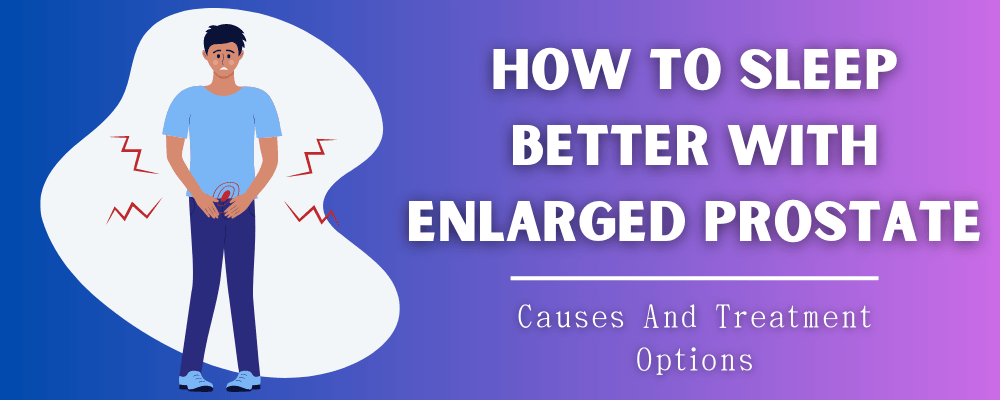Sleep is essential for our overall health and well-being. However, individuals with an enlarged prostate often experience disrupted sleep due to urinary symptoms such as frequent nighttime urination and incomplete bladder emptying.
This article provides a comprehensive overview of enlarged prostate symptoms, causes, and treatment options. It also explains how to sleep better with enlarged prostate and available treatment options.
What Is Enlarged Prostate?
Enlarged prostate, also known as benign prostatic hyperplasia (BPH), is a common condition that affects many men as they age. It occurs when the prostate gland, which is located below the bladder and surrounds the urethra, grows in size and puts pressure on the urinary tract.
For some men, an enlarged prostate can cause uncomfortable symptoms like frequent urination, urgency, and difficulty starting and stopping urine flow. It can also interfere with daily activities, such as sleeping, working, and enjoying time with loved ones.
The Link Between an Enlarged Prostate and Sleep
The symptoms of an enlarged prostate can significantly impact sleep quality. Men may wake up multiple times during the night to urinate, leading to fragmented sleep. Additionally, the discomfort caused by an enlarged prostate can make it challenging to find a comfortable sleeping position, further exacerbating sleep difficulties.
What Causes the Prostate to Enlarge?
Various factors contribute to prostate gland enlargement. Here are discussed some common causes of prostate enlargement, including:
- Age:
Prostate enlargement is strongly associated with ageing. As men age, the risk of BPH increases. Approximately 90% of men over 80 have prostate enlargement. - Hormonal Changes:
Hormonal imbalances, particularly testosterone and estrogen, contribute to prostate enlargement. Testosterone, a manly hormone, is converted to dihydrotestosterone (DHT) within the prostate gland. Excessive levels of DHT can promote prostate cell growth, leading to their enlargement. - Family History:
Having a family history of prostate enlargement increases the likelihood of BPH. If your father or brother has the condition, you may be at higher risk. - Lifestyle Factors:
Lifestyle factors may contribute to prostate enlargement. Sedentary gestation, rotundity, and a diet high in red meat and low in fruits and vegetables are associated with an advanced BPH threat. - Chronic Inflammation:
Chronic inflammation within the prostate gland may contribute to BPH. Inflammation can cause cellular changes and disrupt prostate tissue growth and function. - Ethnicity:
Studies have shown that certain ethnic groups, similar to African-Americans, have a greater risk of prostate damage than other populations. The reasons for these disparities are still being researched.
Symptoms of an Enlarged Prostate
Here are some common symptoms associated with an enlarged prostate:
- Increased Urination Frequency:
One of the primary symptoms of BPH is frequent urination. Men with an enlarged prostate may need to urinate more often, both during the day and at night. This symptom, known as urinary frequency, disrupts sleep and daily activities. - Nocturia:
Nocturia refers to the need to wake up during the night to urinate. Men with an enlarged prostate often experience nocturia, which can disturb sleep patterns and lead to daytime fatigue. Multiple trips to the bathroom at night can significantly impact sleep quality. - Urgency:
BPH can cause a sudden and strong urge to urinate, known as urinary urgency. Men may feel the need to rush to the bathroom, and in some cases, they may struggle to hold back the urge. This may result in urinary incontinence. - Weak Urine Flow:
A weakened urine stream is a common symptom of an enlarged prostate. Reduced flow can make it challenging to initiate urination or maintain a steady stream. Men may also experience intermittent urination, where urine flow starts and stops during urination. - Incomplete Bladder Emptying:
Due to obstruction caused by an enlarged prostate, some men may have difficulty fully emptying their bladder. This sensation of incomplete bladder emptying can lead to discomfort and a constant need to urinate. - Dribbling or Post-void Dribbling:
After urinating, some men may experience dribbling or the involuntary release of a few drops of urine. This can occur due to incomplete bladder emptying caused by BPH. - Urinary Retention:
In severe cases, an enlarged prostate can lead to urinary retention, where the bladder cannot empty properly. This is a serious condition that requires immediate medical attention to relieve the obstruction and prevent complications.
How to Sleep Better with Enlarged Prostate?
Sleep better with enlarged prostate is a big challenge for men. Following these tips for the best sleep.

Managing Symptoms During the Day:
It is essential to manage enlarged prostate symptoms throughout the day to minimize their impact on sleep. This includes avoiding excessive fluid intake before bedtime and emptying the bladder completely before sleep.
Creating a Conducive Sleep Environment:
Designing a sleep-friendly environment can greatly enhance sleep quality. This involves keeping the bedroom cool, dark, and quiet, as well as investing in a comfortable mattress and pillows.
Adopting Sleep-Promoting Habits:
Developing healthy sleep habits can improve overall sleep. This includes establishing a consistent sleep schedule, avoiding stimulating activities before bed, and practising relaxation techniques such as deep breathing or meditation.
Diet and Lifestyle Changes
Foods and Beverages to Avoid Before Bedtime:
Certain foods and drinks can exacerbate urinary symptoms and disrupt sleep. It is advisable to limit caffeine, alcohol, and spicy or acidic foods in the evening. These substances irritate the bladder and increase urinal needs.
Incorporating Exercise into Your Routine:
Regular physical activity has numerous benefits, including improved sleep. Exercise regulates hormone levels, reduces stress, and promotes overall well-being. However, it is wise to avoid vigorous exercise close to bedtime as it may increase urinary symptoms.
Managing Bathroom Trips at Night
Strategies to Minimize Nighttime Bathroom Visits:
To reduce bathroom trips during the night, it can be helpful to limit fluid intake in the evening, especially a few hours before bed. Additionally, emptying the bladder completely before sleep can minimize the urge to urinate during the night.
Strengthening Pelvic Floor Muscles:
Pelvic floor exercises, such as Kegels, can improve bladder control and reduce urinary symptoms. Regularly practising these exercises can improve nighttime bathroom trips.
Bedtime Routine for Improved Sleep
Establishing a Relaxing Routine Before Bed:
Creating a calming bedtime routine can signal to your body that it’s time to unwind and prepare for sleep. This may include activities such as taking a warm bath, reading a book, or practising relaxation exercises.
Incorporating Relaxation Techniques and Mindfulness:
Techniques like deep breathing, progressive muscle relaxation, or guided imagery can relax both the body and mind before sleep. Mindfulness practices, such as meditation or journaling, can also reduce stress and promote sleep better with enlarged prostate.
Sleeping Positions for Comfort
Finding a comfortable sleeping position is essential for prostate patients. Here are some sleeping positions that may alleviate discomfort:
On Your Side:
Sleeping on your side with a pillow between your knees can relieve pressure on the prostate gland and provide better support for the body. This position can be very helpful for sleep better with enlarged prostate.
In an Elevated Position:
Elevating the upper body with a wedge pillow or adjustable bed can reduce pressure on the prostate and alleviate nighttime urinary symptoms.
Diagnosis and medical evaluation
To diagnose an enlarged prostate, healthcare professionals perform a physical exam and assess the patient’s medical history. They may additionally carry out diverse diagnostic tests, including a virtual rectal exam (DRE), a prostate-particular antigen (PSA) blood test, and imaging research like ultrasound or MRI. These tests help evaluate the prostate’s size and condition and rule out other possible causes of urinary problems.
Treatment options for an enlarged prostate
When treating an enlarged prostate, several options are available depending on the severity of symptoms and individual circumstances. Here are some common approaches.
1. Lifestyle Modifications:
Making certain lifestyle changes can alleviate symptoms and improve prostate health. These changes may include:
- Limit fluid intake before bedtime to reduce nighttime urination.
- Avoiding or reducing caffeine and alcohol consumption, as they irritate the bladder.
- Engaging in regular physical exercise promotes urinary flow and overall well-being.
- Relaxation techniques to manage stress, which worsens urinary symptoms.
2. Medications:
Medications are often prescribed to manage prostate symptoms. Commonly used medications include:
- Alpha blockers: These drugs relax the prostate and bladder neck muscles, improving urine flow.
- 5-alpha reductase inhibitors: They block testosterone conversion to DHT, reducing prostate growth.
- Combination therapy: Alpha-blockers and 5-alpha reductase inhibitors are prescribed together for enhanced effectiveness.
3. MINIMALLY Invasive Procedures:
For individuals with moderate to severe symptoms, minimally invasive procedures may be recommended. These procedures aim to reduce the prostate size or relieve urinary obstruction. Some examples include:
- Transurethral microwave thermotherapy (TUMT): This procedure uses microwave heat to destroy excess prostate tissue.
- Transurethral needle ablation (TUNA): Radio waves deliver low-level energy and shrink the prostate.
- Laser therapy: Different types of lasers are used to remove or vaporize prostate tissue.
4. Surgical Interventions:
In cases where other treatment options are ineffective or symptoms are severe, surgical intervention may be necessary. Surgical procedures for an enlarged prostate include:
- Transurethral resection of the prostate (TURP): This is the most common surgery for BPH. It involves removing excess prostate tissue using a resectoscope inserted through the urethra.
- Open prostatectomy: This traditional surgery is performed through an abdominal incision and is usually reserved for extremely large prostates.
- Prostate artery embolization (PAE): This minimally invasive procedure blocks the blood supply to the prostate, shrinking it.
Managing Symptoms at Home
In addition to medical treatments, there are several self-care strategies that can help manage the symptoms of an enlarged prostate. These include:
- Following a balanced diet rich in fruits, vegetables, and whole grains promotes prostate health.
- Practising pelvic floor exercises, such as Kegels, to improve urinary control and strengthen the muscles around the bladder.
- Try herbal remedies and supplements, such as saw palmetto, beta-sitosterol, and pygeum, which have shown promise in reducing prostate symptoms. However, it’s imperative to consult a healthcare professional before using supplements.
Seeking Support
Living with an enlarged prostate may be challenging, and searching for assistance could make a difference:
- Support groups: Joining a support organization or connecting with people living through similar situations can offer you a sense of community, understanding, and emotional assistance.
- Professional counselling: If the effect of an enlarged prostate on your sleep and general health causes you distress, expert counselling will help you control your emotions, increase coping strategies, and enhance your universal quality of life.
When to Consult a Doctor
Despite the fact that lifestyle changes and self-care strategies can help manage enlarged prostate symptoms, medical intervention may be necessary. It is essential to consult a doctor if:
- You experience severe pain or discomfort.
- Urinary symptoms significantly impact your quality of life.
- Your sleep disturbances persist despite implementing various strategies.
- You notice blood in your urine or have difficulty urinating.
Remember that a healthcare professional can advise you, prescribe appropriate treatment and dispel your doubts.

Conclusion
Sleeping better with an enlarged prostate is possible with the right strategies and lifestyle changes. By handling signs throughout the day, creating a sleep-pleasant environment, adopting sleep-selling habits, and in search of suitable treatment, people can enhance sleep excellent and usual well-being. Early detection and timely intervention play a vital role in minimizing the impact of an enlarged prostate on overall health.
Disclaimer:
The information presented in this article is for instructional and informational purposes only. It may not always be necessary to update an expert’s advice, diagnosis, or treatment. Always seek the advice of your health practitioner or another certified healthcare provider with any questions concerning your fitness condition.
Never ignore expert scientific advice based solely on this article. Any reliance you place on the information provided in this article is at your own risk. A healthcare professional should be consulted before making any changes to your medical or treatment routine based on this information.
FAQs.
What is the best sleeping position for BPH?
When it comes to finding the best sleeping position for BPH, lying on your side with a pillow between your legs can help reduce pressure on the bladder and provide relief.
Can an enlarged prostate affect sexual function?

Yes, an enlarged prostate can impact sexual function. It can cause erectile dysfunction, decreased libido, or difficulty ejaculating.
Why is the prostate a problem at night?
The prostate may be a hassle at night time because of benign prostatic hyperplasia (BPH), wherein an enlarged prostate places strain on the urethra, resulting in frequent urination and difficulty sleeping.
What is the link between an enlarged prostate and prostate cancer?
Having an enlarged prostate does not increase the risk of prostate cancer. However, the two conditions can coexist, and some symptoms may overlap. It is imperative to consult a healthcare professional for proper evaluation and diagnosis.
Can an enlarged prostate be prevented?
While it may not be possible to prevent an enlarged prostate entirely, certain lifestyle choices may reduce the risk or slow down the progression. These include maintaining a healthy weight, staying physically active, and consuming a balanced diet rich in fruits, vegetables, and whole grains.

